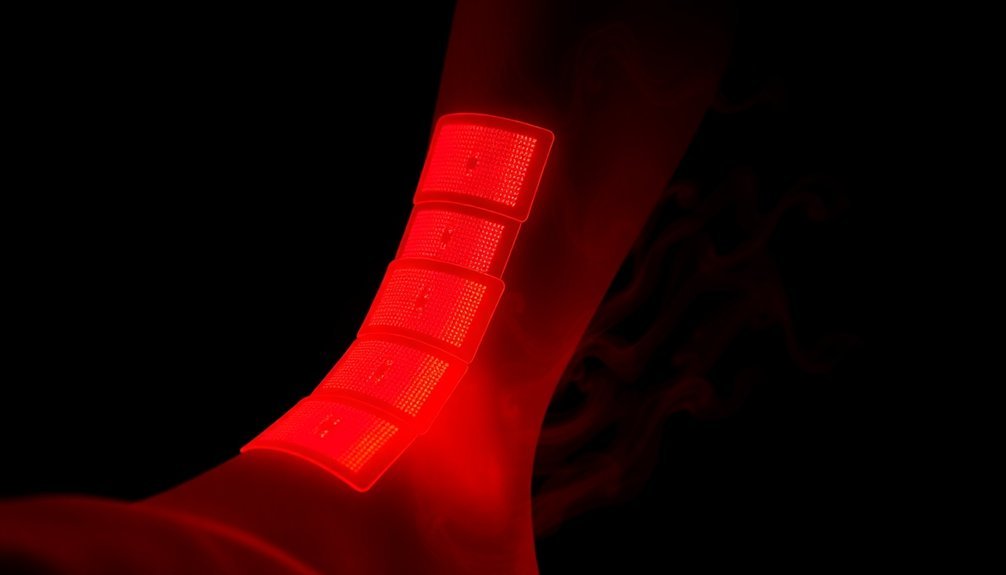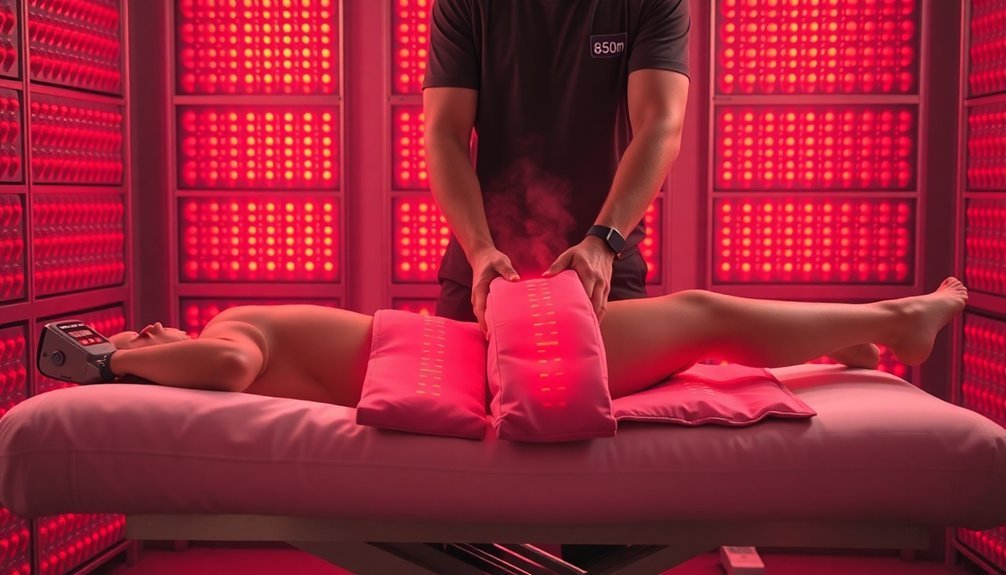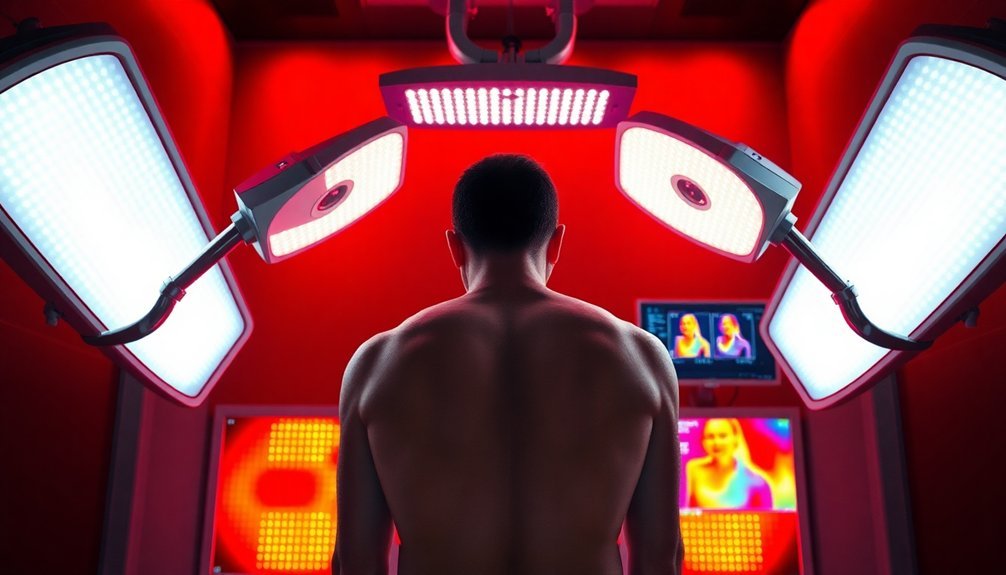For ideal nerve recovery, you'll want to explore five proven infrared treatment methods. MIRE therapy uses specialized diode pads for 30-minute sessions, while near-infrared LED therapy penetrates deep into tissues with 880nm wavelengths. Combined physical-infrared recovery pairs traditional therapy with light treatment, showing a 67% pain reduction. Targeted neuropathy protocols use specific 635-940nm wavelengths to stimulate cellular repair and reduce inflammation. Advanced regeneration systems offer multi-wavelength technology for customized healing. Understanding these powerful treatment options can help you make informed decisions about your nerve recovery journey.
MIRE Therapy Treatment Protocol

MIRE (Monochromatic Infrared Energy) therapy delivers nonvisible infrared light through specialized contact pads placed directly on your skin. During treatment, you'll lie comfortably while flexible pads emit single wavelength light energy from the red end of the spectrum. For hygienic purposes, your healthcare provider will place commercial plastic wrap between your skin and the MIRE pads before beginning the session. These pads contain fifty super-luminous diodes that emit near-infrared light at an 890-nm wavelength.
The standard treatment protocol requires you to commit to three 30-minute sessions per week over a four-week period. Each session typically lasts between 30 to 45 minutes, depending on your specific condition and treatment plan. While you're receiving treatment, you'll need to remain still to maintain proper contact between the pads and your treatment area.
It's important to understand that while MIRE therapy has shown mixed results in clinical studies, you'll need to complete the full recommended protocol to evaluate its effectiveness for your condition. Some patients experience improvements, while others show no significant benefits compared to placebo treatments.
Your healthcare provider should monitor you during sessions for any potential adverse effects, including increased neuropathic pain or skin reactions, though serious side effects are rare.
Near-Infrared LED Light Applications
Near-infrared LED light therapy harnesses specific wavelengths between 630-1000 nm to stimulate nerve recovery and regeneration. When you undergo this treatment, the light penetrates deep into your tissues, enhancing mitochondrial oxidative metabolism and boosting cellular energy production through increased ATP levels.
The therapy can penetrate up to 7 centimeters deep, reaching multiple layers of tissue for comprehensive healing. You'll benefit from improved circulation as the infrared light dilates your blood vessels, delivering essential nutrients to damaged nerve tissues.
The therapy's photobiomodulation effects trigger cellular functions that accelerate healing while increasing antioxidation levels in the nerve regeneration chamber fluid.
You can expect positive results across various nerve-related conditions. If you're suffering from peripheral neuropathy, sciatic nerve pain, or carpal tunnel syndrome, you'll likely experience significant pain reduction and improved nerve function.
The therapy's also shown promise in treating post-concussion symptoms and accelerating wound healing.
The treatment's safety profile means you won't have to worry about significant side effects. You can even combine it with other therapies like PEMF and neurostimulation for enhanced results.
Many patients report long-term relief from neuropathy symptoms, making this therapy a valuable option for nerve recovery.
Combined Physical-Infrared Recovery Methods

The combination of physical therapy and infrared treatments creates a powerful synergy for nerve recovery. You'll experience enhanced healing through the dual approach of targeted exercises and infrared light therapy, which work together to reduce pain and inflammation at the cellular level. Studies have shown a remarkable 67% reduction in pain after just 60 days of combined treatment. The therapy's effectiveness extends to addressing autonomic nerve function, improving systems like blood pressure regulation and digestion.
| Physical Therapy Benefits | Infrared Therapy Benefits |
|---|---|
| Therapeutic exercises | Cell-level healing |
| Stretching routines | Blood vessel dilation |
| Cardiovascular health | Nitric oxide release |
| Balance training | Nerve regeneration |
| Mobility enhancement | Pain reduction |
You'll notice improved circulation as the infrared light dilates blood vessels while physical therapy movements enhance blood flow. This combination accelerates nerve repair and regeneration, leading to better mobility and balance. The non-invasive nature of these treatments means you won't have to worry about medication side effects.
Your treatment plan will be tailored to your specific needs, combining targeted exercises with precise infrared light exposure. This holistic approach addresses both symptoms and underlying causes, providing thorough healing that surpasses single-therapy results.
Targeted Neuropathy Light Treatment
Three key wavelengths of targeted infrared light therapy provide powerful relief for neuropathy patients, operating at depths between 635 and 940 nanometers. These specific wavelengths penetrate deep into your tissues, where they'll repair and regenerate damaged nerve cells faster than your body's natural healing rate.
You'll benefit from this non-invasive treatment through a process called photobiomodulation, which stimulates cellular repair and reduces inflammation at its source. The near-infrared wavelengths are particularly effective because they can reach deeper nerve damage, accelerating your natural regeneration speed beyond the typical 1mm per day.
When you undergo targeted light therapy, you can expect significant improvements within 60 days. Clinical studies show you'll likely experience a 67% reduction in pain and a 66% decrease in numbness.
The treatment works by dilating your blood vessels, increasing circulation to damaged nerves, and delivering more oxygen and nutrients to affected areas.
You can maximize your results by using devices that combine both red and near-infrared light. This targeted approach isn't just effective on its own – it works well alongside physical therapy for thorough nerve recovery.
Advanced Infrared Regeneration Systems

Modern infrared regeneration systems integrate multiple wavelengths between 700-1,000 nanometers to maximize nerve recovery outcomes. You'll find these advanced systems utilize LED photobiomodulation technology that penetrates up to 7 cm deep into your tissue, targeting damaged nerves with precision. The newest devices feature adjustable intensity controls and FDA-cleared components that guarantee both safety and effectiveness.
| System Feature | Clinical Benefit |
|---|---|
| Multi-wavelength Technology | Targets different tissue depths simultaneously |
| Intensity Control | Allows customization for specific conditions |
| Deep Penetration | Reaches nerve structures up to 7 cm deep |
| LED Configuration | Provides consistent, uniform light distribution |
| Smart Temperature Control | Maintains ideal therapeutic levels |
When you're using these systems, you'll benefit from their ability to stimulate mitochondrial oxidative metabolism, which accelerates axonal growth and promotes nerve regeneration. Today's devices incorporate sophisticated monitoring systems that track your treatment progress and adjust parameters accordingly. The technology's non-invasive nature means you won't experience side effects common with traditional treatments, while still achieving significant improvements in nerve function and reduced neuropathy symptoms.
Frequently Asked Questions
Can Infrared Therapy Worsen Existing Nerve Conditions if Used Incorrectly?
Yes, if you're using infrared therapy incorrectly, you can worsen nerve conditions through overexposure, wrong dosage, or improper wavelengths. That's why you'll need proper medical supervision for safe treatment.
How Long Do the Benefits of Infrared Therapy Typically Last After Treatment?
You'll typically experience short-term benefits lasting days to weeks, while medium-term effects can continue for months. With consistent treatment, you may maintain long-term improvements in nerve health for several months to years.
Are There Any Age Restrictions for Receiving Infrared Therapy Treatment?
You can receive infrared therapy at any age, but you'll need parental consent if you're under 18. While there's no strict upper age limit, you should consult your doctor if you have health concerns.
Does Insurance Typically Cover Infrared Therapy for Nerve Recovery Treatment?
You'll typically find that standard insurance and Medicare don't cover infrared therapy for nerve recovery. However, some Medicare Advantage or private insurance plans might offer coverage, so you should check with your provider directly.
Can Infrared Therapy Be Used While Taking Nerve-Related Medications?
Yes, you can safely use infrared therapy while taking nerve-related medications. It's generally considered a complementary treatment that won't interfere with your medications, though you should consult your healthcare provider before starting treatment.
In Summary
You'll find infrared treatments offer promising solutions for nerve recovery when used consistently and properly. Whether you choose MIRE therapy, LED applications, or combined methods, stick to recommended protocols for best results. Remember to consult your healthcare provider before starting any treatment plan, and track your progress regularly. With these advanced options available, you're better equipped to address nerve-related challenges effectively.





Leave a Reply